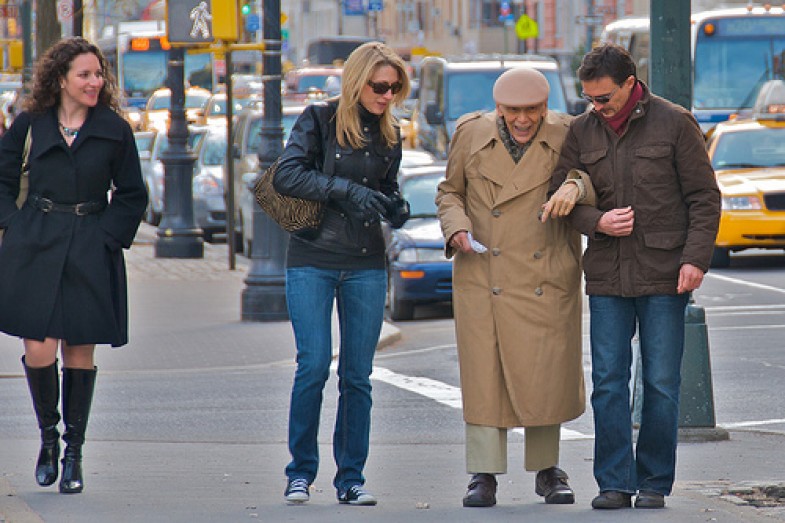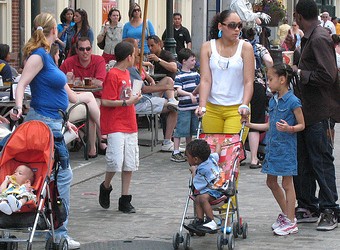More than 4500 pedestrians (see earlier Commons magazine story) are killed by motor vehicles every year on the streets of America. This is not an inevitable fact of modern life. These deaths are preventable, as shown by the dramatic decline of pedestrian fatalities (as well as bicyclists and motorists) in Sweden after they adopted the Vision Zero approach to traffic safety.
The gravest danger to walkers and bicyclists, as well as motorists, is other motorists who drive recklessly. According to data collected by the New York City Department of Transportation from 2008-2012, “dangerous driver choices” contribute to pedestrian deaths in 70 percent of cases. “Dangerous pedestrian choices” is responsible in 30 percent of cases and joint responsibility in 17 percent of cases.
As the old saying goes, speed kills. Two landmark studies, one from the US and one from the UK, found that pedestrians are killed:
-5 percent of the time when struck by a car traveling 20 mph
-37-45 percent of the time when struck by a car traveling 30 mph
-83-85 percent of the time when struck by a car traveling 40 mph.
In light of these findings, it’s scary to realize that traffic on many if not most American roads travels closer to 40 mph than 20 mph.
“If we could do one switch to make safer streets it would be to reduce car speeds to 20 mph, which would reduce pedestrian fatalities by 90 percent,” says Scott Bricker, Executive Director of the America Walks pedestrian advocacy network. America Walks also plays a role in Every Body Walk!, a collaborative of citizens, businesses and organizations across many fields convened by the health care non-profit Kaiser Permanente.
This means more than lowering speed limits. Charlie Zegeer, project manager at the University of North Carolina’s authoritative Pedestrian and Bicycle Information Center (PBIC) says, “Research shows that lowering a speed limit without other improvements like road design changes or improved police enforcement doesn’t work to slow traffic-- it’s the roadway design that affects the speed.”
Here’s a few of practical steps to slow speeds, deter distracted driving and help make walking a safer, comfortable and enjoyable experience for everyone. This is where Vision Zero hits the road.
--Reduce the number of travel lanes on wide streets wherever possible. Downsizing four-lane suburban and urban streets to two travel lanes with an alternating turn lane in the middle has become a popular trend across the country. Not only does this create safer streets, it lessens noise for residents and creates an opportunity to add sidewalks, bike lanes and landscaping. (This is known as a road diet, lane reduction or 2+1 road.)
--Reduce the width of travel lanes. Wide lanes send an unmistakable message for drivers to speed up.
--Reduce the length of crosswalks. A shorter walk across the street is a safer one. This can be done in a number of ways, but most commonly by extending the sidewalk out into the intersection. (This is known as a curb extension or bulb-out.)
--Add raised medians islands in the middle of busy streets as a refuge for crossing pedestrians. This has been shown to reduce traffic accidents by 56 percent, according to Gil Penalosa of 8-80 Cities.
--Make crosswalks more visible. Elevate them to curb level (known as speed tables), or brightly mark them with wide swaths of paint.
--Give pedestrians a head start at traffic lights. Five seconds allows pedestrians to enter the crosswalk first and be more visible to motorists, says Penalosa. Lining up waiting cars a few feet back from the intersection can also be helpful.
--Ban right on red turns at busy intersections. Drivers, busy watching out for other cars, often don’t see pedestrians crossing the street on green lights.
--Keep the turning radius 90 degrees at intersections. Rounded street corners encourage drivers to turn without stopping or looking for pedestrians.
--Install traffic circles, roundabouts, speed humps, raised crosswalks and other traffic calming devices, which help motorists drive safely and keep an eye out for pedestrians.
--Convert one-way streets to two-way, which encourages safer, slower driving.
--Pay close attention to road designs at bus stops. Pedestrians often rush across the street to catch their bus, not paying attention to oncoming traffic.
-Create pedestrian streets, bridges and underpasses in busy areas where other measures are not feasible to minimize conflict with traffic and enhance the convenience of walking.
--Separate bike lanes from car lanes on busy streets. Protected bike lanes create a more comfortable, enjoyable trip for pedestrians too.
--Strict enforcement of laws against speeding, failure to yield to pedestrians, drunk driving and reckless driving. The loss of loved one killed by a car is no less tragic than one killed by a gun.
--Install red light cameras and other of means photo enforcement. It’s expensive to station a police car at every unsafe intersection, but technology can nab lawbreakers at a fraction of the cost. Washington, DC now uses cameras to detect and fine drivers who do not yield right-of-way to pedestrians as well as those who speed or run red lights, says Charlie Zegeer of the Pedestrian and Bicycling Information Center.
--Establish Safe Routes to Schools campaigns, which bring educators, parents, neighbors and kids themselves together to find safe, satisfying ways for students to walk and bike to school.
--Implement training programs about pedestrian safety for traffic engineers, transportation planners, police, city officials, citizens and children. “All the kids in the Netherlands have three weeks instruction in the rules of the road at school,” notes Penalosa. “They role play being pedestrians, bicyclists and drivers.”
--Put Pedestrians First. “Every city should have a by-law of one sentence stating: “In this city, pedestrians come first,” declares Penalosa. “Everyone is a pedestrian at some point during the day, even if you are just walking from your parking space. So everyone has a stake in Vision Zero.”
“These pedestrian improvements also typically improve motorists’ and bicyclists’ safety,” Zegeer adds. “It’s a win-win-win. Everyone’s safer.”






